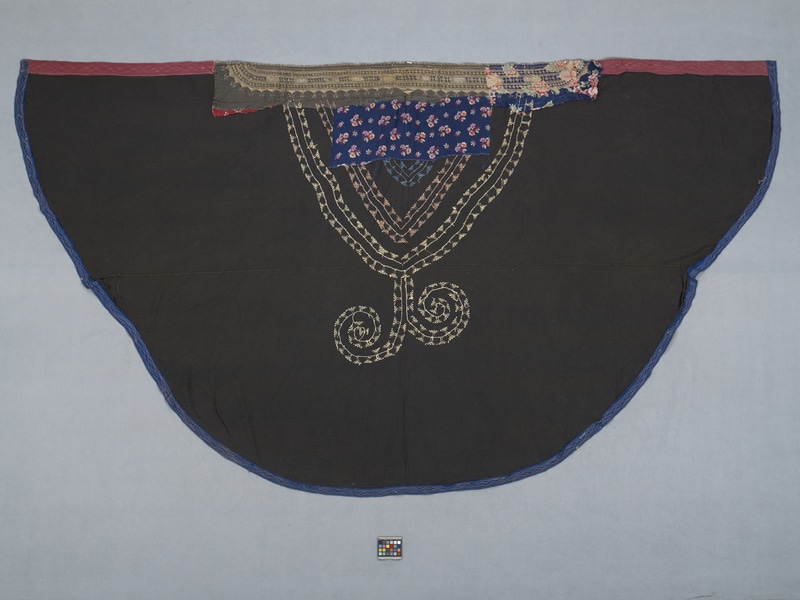Chadri Shawl Item Number: 2878/20 from the MOA: University of British Columbia


Description
Large, black women's shawl, or veil, with a rectangular embroidery panel centred along the straight edge (when worn this panel falls around the head/face of the wearer). There are four main sections to the design of the panel which are separated by gold stitching: the section closest to the outer edge is two lines of red and green cotton; the largest section of design has light orange, green and red cotton sewn into the embroidery, the main pattern of which consists of gold diamond and rectangular shapes; on the outer edge of the four sections there are triangle and arrow shapes. On the interior of the semi-circular shawl, around the top, there is a small piece of cotton material with a blue background and red and green flowers, sewn as a lining where the shawl would rest on top of the wearer's head. The inside edges of the shawl are also lined: the front seams are lined with a narrow strip of red fabric, and the bottom seams are lined with a narrow strip of blue fabric. On the exterior surface of the shawl, extending out from the central embroidery panel, there is a hand-sewn geometric design consisting of three V-shaped sets of linear patterns. Each of these is a different colour (from closest to the embroidery panel out: light blue, light orange and light yellow). All three consist of two lines and there are flower-like designs sewn on the outside edge of each of the lines. The yellow lines, which are the closest to the bottom of the shawl, have two snail shell designs that extend down from the two main lines.
History Of Use
The intricacy of the embroidery is an indication of a woman's wealth and skill as an embroiderer. Married or betrothed Kuchi women traditionally wear a large black chadri, while younger unmarried girls instead wear a flower-patterned red shawl loosely draped over their head and shoulder.
Specific Techniques
Made of black cotton strips assembled by hand-stitching, with a gold thread embroidered head/face panel stitched separately and then hand-stitched onto the body of the veil. Embroidered designs on the back of the chadr are done by hand with yellow, orange and blue (possibly indigo-dyed) cotton yarn. The machine-made gold-embroidered head/face panel trim appears to have been sewn into the garment after the cotton body was pieced together (likely an older embroidered panel attached to a newer cotton garment).
Item History
- Made in Afghanistan
- Collected in Herat, Afghanistan during 1974
- Owned by Tamarin Productions Inc. before May 4, 2011
- Received from Tamarin Productions Inc. (Seller) and Ruth Read Bequest (Funding source) on May 4, 2011
What
- Name
- Chadri Shawl
- Identification Number
- 2878/20
- Type of Item
- shawl
- Material
- cotton fibre
- Overall
- height 150.5 cm, width 210.0 cm
Who
- Culture
- Pashtun: Kuchi
- Previous Owner
- Tamarin Productions Inc.
- Received from
- Tamarin Productions Inc. (Seller) and Ruth Read Bequest (Funding source)
Where
- Holding Institution
- MOA: University of British Columbia
- Made in
- Afghanistan
- Collected in
- Herat, Afghanistan
When
- Collection Date
- during 1974
- Ownership Date
- before May 4, 2011
- Acquisition Date
- on May 4, 2011
Other
- Item Classes
- textiles
- Condition
- fair
- Accession Number
- 2878/0020